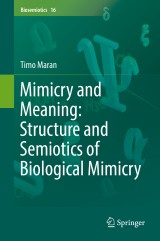Details

Mimicry and Meaning: Structure and Semiotics of Biological Mimicry
Biosemiotics, Band 16
|
128,39 € |
|
| Verlag: | Springer |
| Format: | |
| Veröffentl.: | 11.01.2017 |
| ISBN/EAN: | 9783319503172 |
| Sprache: | englisch |
Dieses eBook enthält ein Wasserzeichen.
Beschreibungen
<p>The present book analyses critically the tripartite mimicry model (consisting of the mimic, model and receiver species) and develops semiotic tools for comparative analysis. It is proposed that mimicry has a double structure where sign relations in communication are in constant interplay with ecological relations between species. Multi-constructivism and toolbox-like conceptual methods are advocated for, as these allow taking into account both the participants’ Umwelten as well as cultural meanings related to specific mimicry cases.</p><p>From biosemiotic viewpoint, mimicry is a sign relation, where deceptively similar messages are perceived, interpreted and acted upon. Focusing on living subjects and their communication opens up new ways to understand mimicry. Such view helps to explain the diversity of mimicry as well as mimicry studies and treat these in a single framework. On a meta-level, a semiotic view allows critical reflection on the use of mimicry concept in modern biology. <br></p><p>The author further discusses interpretations of mimicry in contemporary semiotics, analyses mimicry as communicative interaction, relates mimicry to iconic signs and focuses on abstract resemblances in mimicry. Theoretical discussions are illustrated with detailed excursions into practical mimicry cases in nature (brood parasitism, eyespots, myrmecomorphy, etc.). The book concludes with a conviction that mimicry should be treated in a broader semiotic-ecological context as it presumes the existence of ecological codes and other sign conventions in the ecosystem.<br></p><p></p>
<p>1 Biosemiotics of mimicry: introductory notes.- 2 First excursion: the history of the mimicry concept.- 3 The structure of mimicry.- 4 Semiotics of mimicry.- 5 Iconicity and mimicry.- 6 Second excursion: importance of the object.- 7 Different perspectives in mimicry system.- 8 Modelling mimicry.-9 Mimicry and semiotic evolution.- 10 Third excursion: an epistemology of the uncertain.- 11 From abstract mimicry to ecological codes.- 12 Conclusions</p>
Timo Maran is Editor in Chief of Biosemiotics journal.
<p>The present book analyses critically the tripartite mimicry model (consisting of the mimic, model and receiver species) and develops semiotic tools for comparative analysis. It is proposed that mimicry has a double structure where sign relations in communication are in constant interplay with ecological relations between species. Multi-constructivism and toolbox-like conceptual methods are advocated for, as these allow taking into account both the participants’ Umwelten as well as cultural meanings related to specific mimicry cases.</p><p>From biosemiotic viewpoint, mimicry is a sign relation, where deceptively similar messages are perceived, interpreted and acted upon. Focusing on living subjects and their communication opens up new ways to understand mimicry. Such view helps to explain the diversity of mimicry as well as mimicry studies and treat these in a single framework. On a meta-level, a semiotic view allows critical reflection on the use of mimicry concept in modern biology. </p>
The author further discusses interpretations of mimicry in contemporary semiotics, analyses mimicry as communicative interaction, relates mimicry to iconic signs and focuses on abstract resemblances in mimicry. Theoretical discussions are illustrated with detailed excursions into practical mimicry cases in nature (brood parasitism, eyespots, myrmecomorphy, etc.). The book concludes with a conviction that mimicry should be treated in a broader semiotic-ecological context as it presumes the existence of ecological codes and other sign conventions in the ecosystem.
The author further discusses interpretations of mimicry in contemporary semiotics, analyses mimicry as communicative interaction, relates mimicry to iconic signs and focuses on abstract resemblances in mimicry. Theoretical discussions are illustrated with detailed excursions into practical mimicry cases in nature (brood parasitism, eyespots, myrmecomorphy, etc.). The book concludes with a conviction that mimicry should be treated in a broader semiotic-ecological context as it presumes the existence of ecological codes and other sign conventions in the ecosystem.
Popularity of mimicry studies in evolutionary and theoretical biology Unique profile of the manuscript focused on biosemiotics and communication aspect of mimicry Potential of biosemiotics as a developing field for a wider epigenetic movement in biology (e.g. evo-devo, systems biology)
Diese Produkte könnten Sie auch interessieren:

The Vicuña

von: Iain Gordon, Jane C. Wheeler, Hugo Yacobaccio, Jerry Laker, Marcelo Cassini, Mariela Borgnia, Yanina Arzamendia, Verónica Benítez, Bibiana Vilá, Cristian Bonacic, Jessica Gimpel, Pete Goddard, Desmond McNeill, Gabriela Lichtenstein, Renaudeau d' Arc Nadine, Kristi Anne Stølen, Javier García Gomez, Ana Wawrzyk

96,29 €

Saving Biological Diversity

von: Robert A. Askins, Glenn D. Dreyer, Gerald R. Visgilio, Diana M. Whitelaw

96,29 €

Martens and Fishers (Martes) in Human-Altered Environments

von: Daniel J. Harrison, Angela K. Fuller, Gilbert Proulx

149,79 €













